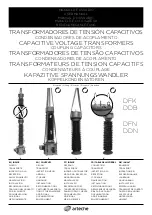
Series PC Manual V 1.0 - Rev. 3
– 03/01/01
DS Europe
11
6. FLOATS
6.1.
INSTALLATION ADVICES
•
The magnet inside the float (usually in the middle or on the top) is placed towards the
measuring head: in order to reduce or cancel (Fig. 3) the dead length (A) of the probe
end.
The top of the float closer to the magnet is marked by a coloured dot.
•
When the float is used in the liquid, it must remain upright in order to reduce probe
contact friction and avoid possible measuring errors resulting from different positions
that may be taken up, with respect to the measuring probe.
6.2.
BALLAST
For measurement (Fig. 3) of two liquids with different specific gravities, in a tank with two
floats, be sure that the float has been “sunk”.
Drill a tiny hole (1÷1,2 mm max). Introduce as much lead or heavy liquid that is required. Then
weld the hole close.
7. TRANSDUCER INSTALLATION
NOTE 1): Radial movements of the probe with respect to the cursor or vice versa, due to
vibration, shocks or not good axiality of the probe, do not have a great effect on
measuring.
NOTE 2): The PCS and PCP models are supplied in two versions: in one version the parts
which come into contact with liquid are made of stainless steel and welded to one another
(suffix: – S) and in the other version these parts are made of aluminium and glued to one
another (suffix: - A).
In the aluminium version (-A), great attention must be taken to prevent vibration, shocks or
overpressure that could damage the transducer.
7.1.
MOD. PCS (S = Standard)
The measuring probe is fitted with a threaded union.
The thread is: M 18 x 1,5. The thread on the fixed side ( on the base of the hydraulic
actuator, on the tank) can have cylindrical or conical sealing.
The sealing must be effected with an O-Ring inserted in the union or in the fixed part.
When the
probe is very long
(more than one metre), It is advisable to take special
constructive provisions to prevent undesired excessive probe wavering (more than 1-2
mm) or swinging due to vibration and shocks.
It is to be considered the possibility of using a magnetic cursor with a radial slotting system
(Mod. ARR-2E) through which It can pass the probe anchorage.












































